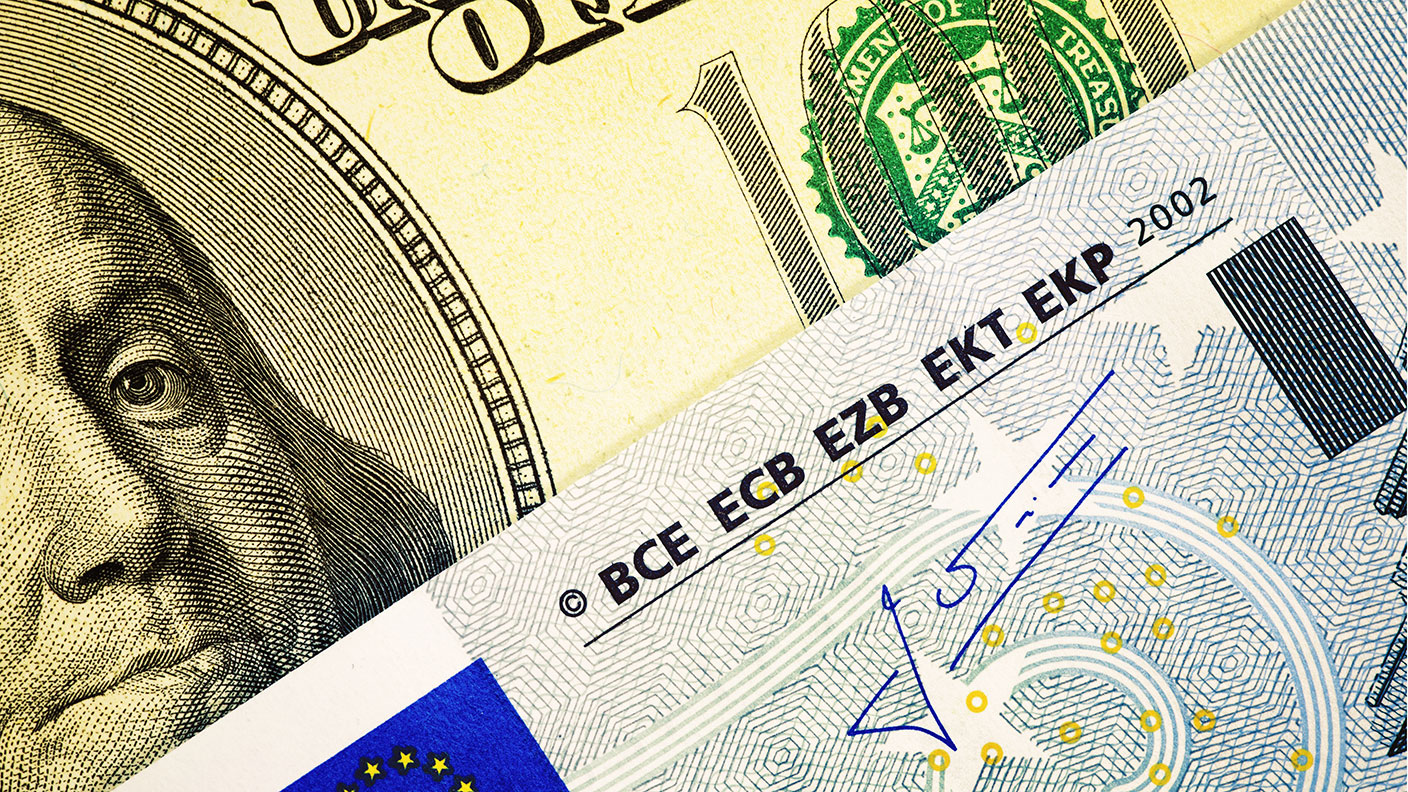Currency Corner: the US dollar could go a lot higher against the euro
Since the 2008 financial crisis, the euro has been in a steady decline against the US dollar. That's likely to continue, says Dominic Frisby. Here's how to make sure you're on the right side of the trade.


For today’s Currency Corner, I wanted to find a pair with a trading signal we can act on right now. I looked high and low, surveying currencies as exotic as the Philippine peso, the Egyptian pound and the Hungarian forint, but most seem locked into well-established trends or ranges. To add a bit of excitement to today’s missive, I wanted something a bit more immediate. Lo and behold I found it in the first place I should have looked – the euro and the US dollar.
Here’s a great statistic for you: the US dollar makes up one side of 88% of global daily forex trades. When you consider how much bigger the forex markets are than the bond or stockmarkets, you realise what an extraordinarily large sum of money that is. The euro, meanwhile, makes up 32%. In third place is the Japanese yen on 17% (this all adds up to more than 100% because, of course, there are two sides to every currency trade).
No wonder so many people hang on the every utterance of Jerome Powell, chair of the Federal Reserve, America’s central bank. And no wonder China has designs on global reserve currency status – it’s an extraordinarily powerful position to occupy.
MoneyWeek
Subscribe to MoneyWeek today and get your first six magazine issues absolutely FREE

Sign up to Money Morning
Don't miss the latest investment and personal finances news, market analysis, plus money-saving tips with our free twice-daily newsletter
Don't miss the latest investment and personal finances news, market analysis, plus money-saving tips with our free twice-daily newsletter
Meanwhile, the US dollar makes up 62% of global foreign exchange reserves (that is, money held by central banks) compared to 20% for the euro. It’s interesting to note that the US dollar allocation has been steadily drifting lower this century. In 2000, it was 73%. That said, while this is something to note, I wouldn’t get too excited about it. In the 1970s, the US dollar accounted for 85% of reserves, but by 1990 it had slipped below 50%. So where we are now doesn’t necessarily represent “demise of the dollar” territory.
The euro’s long bear market against the US dollar
Anyway, here’s a long-term chart of EURUSD so you can see the range. When the chart is rising, the euro is strengthening against the dollar, and vice versa.

Peak US dollar strength came shortly after the turn of the century, when one euro cost just less than $0.85. Peak US dollar weakness came shortly before the onset of the Global Financial Crisis in 2008, with one euro buying you close to $1.60. Since 2008, the euro has been in a long decline against the dollar (although there have been sharp counter-trend rallies). Today the euro sits at $1.10. The present bear market has been ongoing since early 2018, when the price was $1.25.
So that’s the range clearly established. It’s fairly clear that the broader direction is down.
Zooming into a chart of the last three years, I have marked the “sell” signals with red arrows. The “buy” occurs when the six-week exponential moving average (6EMA – the red line) crosses up through 21-week exponential moving average (21EMA – the blue line). And the “sell” occurs when the 6EMA crosses down through the blue line.

You can see we got a nice buy signal in April 2017 that took us through until April 2018, when we got a sell signal. That period of euro strength/US dollar weakness reversed, and we got a year of US dollar bull market.
In June 2018 the euro appeared to stabilise and we got a buy cross. That quickly reversed however and we got a sell – the trade did not work out and lost money. (You can see the two red arrows appearing in quick succession). Precisely the same thing has just happened again. We got a buy cross in late 2019, that this week has reversed – and we have a sell signal.
Now it might be that we are going into a period of range-trading. If so, this strategy will lose money. But if this is a resumption of the ongoing trend – US dollar higher, euro lower – then this system will make sure you are on the right side of it.
Who is debasing their currency more – the Fed? Or the European Central Bank (ECB)? Currently that prize goes to the ECB (just), so you have them on your side. Nobody knows of course, but looking at the long-term chart – ie the bigger picture – I’d say that there is every chance this one goes to $1.05. And if that gives way, we are headed back below parity. Donald Trump would hate that. He wants a weaker dollar. But the US dollar is bigger than he is. And a trend is a trend.
• Dominic’s new book Daylight Robbery: How Tax Shaped Our Past And Will Change Our Future, published by Penguin Business, is available at Amazon and all good bookshops. Audiobook at Audible.co.uk. Signed copies are available at dominicfrisby.com
Get the latest financial news, insights and expert analysis from our award-winning MoneyWeek team, to help you understand what really matters when it comes to your finances.
Dominic Frisby (“mercurially witty” – the Spectator) is as far as we know the world’s only financial writer and comedian. He is the author of the popular newsletter the Flying Frisby and is MoneyWeek’s main commentator on gold, commodities, currencies and cryptocurrencies. He has also taken several of his shows to the Edinburgh Festival Fringe.
His books are Daylight Robbery - How Tax Changed our Past and Will Shape our Future; Bitcoin: the Future of Money? and Life After the State - Why We Don't Need Government.
Dominic was educated at St Paul's School, Manchester University and the Webber-Douglas Academy Of Dramatic Art.
You can follow him on X @dominicfrisby
-
 Where did house prices rise and fall the most in 2025?
Where did house prices rise and fall the most in 2025?Some parts of the UK have seen yearly property price growth of up to 12.6%, but others have seen values fall by as much as 8.9%, research shows.
-
 ‘Why I have ditched my Help to Buy ISA for cash savings and the stock market’
‘Why I have ditched my Help to Buy ISA for cash savings and the stock market’Without the 25% bonus, my Help to Buy ISA is effectively redundant, says MoneyWeek writer Sam Walker.
